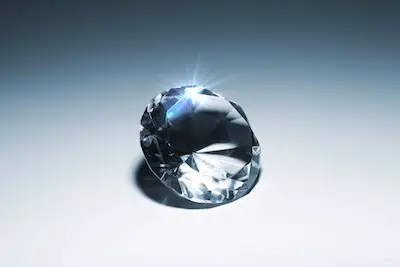There are repetitive tetrahedral 3-D tetrahedral structures formed by the carbon atoms in diamond which connect each atom to four other atoms. This repetitive structure is what makes diamonds stronger than mixtures because it is a strong chemical bond. Mixtures are created by physical bonds and can be distilled, filtered, or otherwise separated by other physical means.
Diamond is an element. Diamond cannot be classified as a compound because compounds are defined as chemical substances made up of molecules that are identical to each other and consist of atoms of more than one chemical element. Diamond is also not a mixture as mixtures are defined as physical combinations of two or more substances that retain their identity and are mixed without exact ratios e.g brass is a mixture of copper (Cu) and Zinc (Zn).
Going on in this article will be comparing compounds and elements and explaining the major differences between them. We’ll also discuss what separates diamonds from other elements made from carbon we will also discuss diamond’s properties and the significance of diamonds in jewelry making and the grading system of diamonds used by jewelers.
What are diamond’s properties?
Atoms are made up of protons electrons and neutrons and diamond is actually made of carbon atoms and every carbon atom has between six to eight neutrons and 6 protons.
Protons are subatomic particles carrying a positive charge and neutrons are subatomic particles with no charge. Electrons are subatomic particles that carry a negative charge and of the three subatomic particles, neutrons have the most mass.
Carbon has several isotopes, Isotopes are atoms of the same element containing the exact same number of protons but a varying number of neutrons. Despite the difference in the numbers of these isotopes’ subatomic particles, Isotopes of the same elements have very similar physical properties.
The carbon atom can be carbon-12 carbon-13 and carbon-14 this is due to the difference in the number of protons. This total number of isotopes is also known as the mass number of a carbon atom.

The atoms of elements made of carbon differ in their structure and this unique characteristic is known as allotropy. For instance, in graphite which is also an allotrope of carbon the atoms have a hexagonal structure while the atoms in a diamond have a three-dimensional structure with four attachments.
This is why graphite breaks easily because the three bond attachments possessed by its atoms are weak and make it soft. Due to this difference in allotropy diamond has a density of 0.020lb/in (3.515 g/cm) while graphite has a density of 0.012 lb/in (2.267 g/cm)
Diamond tetrahedral structure makes it
- incredibly hard
- resistance to many chemical processes
- a poor conductor of electricity due to its lack of free electrons or ions
- a very good conductor of both heat and sound
The carbon cycle is the major influence on the formation of diamonds on the surface of the earth ( the carbon cycle is a continual process in which carbon atoms move between the atmosphere and the earth. Due to our planet and the atmosphere forming a closed system, the total amount of carbon does not change).
The molecules of different species break down to form carbon. During this process, diamond acquires traces of atoms of other elements like hydrogen for example. Hence diamonds are classified into 4 different types based on the impurities they contain.
Type Ia has an impurity composition of around 0.03% while Type IIa and Type IIb have very little to no trace of impurity.
What Are the Differences Between Elements and Compounds?
Elements are constituted of a single type of atom characteristic to that element while compounds are made up of atoms of multiple elements, the elements in compounds are combined in definite ratios, which makes it possible for these proportions to be expressed in a chemical formula that is unique to each compound e.g There are previously defined ratios of hydrogen and oxygen in the water that is where water gets the chemical formula H20 from. Other differences are
The total number of compounds and elements
The American Institute of Physics states that elements are 118 in number with 14 occurring naturally on the earth and the rest being created by radioactivity. Compounds on the other hand are innumerable.
Their Representation
A chemical symbol is used to represent an element while a chemical formula represents a compound i.e. The chemical formula of water is H20 while hydrogen’s chemical symbol is H.
Characteristics of elements in a compound
The behavior of elements in a compound differs in various settings and temperatures i.e at room temperature, oxygen and hydrogen exist in a gaseous state while water under the same conditions and temperature water exists as a liquid.
Main uses of Diamond
This element is popular for its use in making jewelry due to its durability and beauty. It is so important that the jewelry industry created a grading system for diamonds known as the four C’s.
This is an acronym for different metrics used to estimate the value of a diamond
Cut: They are different ways to cut a diamond the most popular cuts are emerald, heart, princess, round, and Oval. A diamond gets its sparkle from how good the quality of its cut is. Diamonds with wider diameters have larger crowns which make them appear to be larger than they are. However, these larger Diamonds may not have a heavier carat weight.
Selecting the best cut for a diamond is very important in determining the stone’s final value and how beautiful it is. Amongst the four C’s it is one of the most technically difficult and complicated characteristics to analyze.
The GIA diamond cut grade also takes into account the design and craftsmanship of a diamond and it contains 5 grades ranging from excellent to poor and is a definitive scale for estimating the value of a diamond cut
Color: Diamonds from D to F have no color while diamonds classified in the G to J range have a little color and diamonds in the K to Z range have very noticeable color. Diamonds with pure color are the most expensive ie green diamonds, brown diamonds, yellow diamonds, pink diamonds, red diamonds, and orange diamonds.
The most expensive diamonds are orange diamonds due to them being rarer than all the other diamond colors and no diamond producer offers a regular supply of this color so far. The most commonly occurring colors are brown and yellow. The GIA has a color scale from D to Z because prior to its creation there was no generally accepted standardized system but a variety of systems already used loosely with the terms A, B, and C already being used.
The GIA scale starts on the letter D to avoid confusion with other scales and while some of these other scales are still in use none of them are as widely accepted or as clear as the GIA color scale
Clarity: The clarity of a diamond is dependent on internal features called inclusions and external features called blemishes.
Evaluating the clarity of diamonds involves estimating several features such as the size, relief, number, position, and nature of these characteristics. When estimating the clarity of a diamond always keep in mind that no diamond is perfectly pure but the clarity is defined by how close it comes to purity.
The GIA diamond clarity scale has 6 categories ranging from Flawless (FL) which has the highest value to Included which is further divided into three grades I1, I2, and I3.
The GIA diamond scale has the flawless diamond category as the most valuable and the included grade diamond category as the least valuable and these categories can be further divided into 11 grades.
The GIA clarity scale came to be due to the need for a standardized grading system because different jewelers were using different terms that could easily be misinterpreted. However, if now you buy a diamond anywhere in the world the jeweler will most likely use terms from the GIA scale. Inclusions in diamonds are caused by crystals that are trapped in a diamond while it forms.
So these inclusions and their size location and visibility are a very important part of the standards used to evaluate diamond clarity. Inclusions and blemishes are very small and are too little to be seen by anyone except a trained diamond grader with the necessary tools because to the naked eye the flawless diamond and an internally flawless diamond may look the same.
This is why getting expert assessments is important to truly understand the value of a diamond
Carat: the heavier a diamond is the more value it has in the market a carrot is equal to 200 mg and it is believed by some that the correct measurement came about because traders used the weight of a carob seed to estimate the weight of diamonds this was also believed because a carrot and a carob seed have a similar constant rate of 200 mg consequently the word carrots was derived from carob.
Subsequent studies however revealed that carob seeds do not have a consistent rate of 200 mg and that Traders might have preferred receipt because they were readily available and not due to a constant weight This information will help you understand product specifications more and give you insight into their importance the variety of karate kids in consumer jewelry make them affordable gifts due to you being able to select the carat weight that you can afford.
Also, the mining process through which diamonds are obtained affected their price. Conflict-free diamonds are more valuable because they were obtained without links to rebel militia or treated for reasons like de-stabilizing governments.
This certification process was started in South Africa in 2000 by diamond-producing countries and in 2003 the Kimberley Process Certification Scheme (KPCS) Was created to satisfy each term improve that it was mined and traded ethically. There are 82 countries that are party to the Kimberley process and all these member countries only trade with countries following these guidelines set by the KPCS.
The source of diamonds also influences its market value depending on where a diamond is sourced its value can increase or decrease. Buyers prefer buying diamonds mined in countries like Canada because they are conflict-free and their miners work under reasonable conditions employed by diamond producers that abide by the laws set for its trade.
Final Thoughts
In conclusion, diamond is an allotrope of carbon, meaning that it is one of the physical forms in which carbon exists it might also contain a negligible amount of impurities of other elements like nitrogen or boron, it is an element that is very resistant to chemical activity due to its strong bonds.
Its three-dimensional tetrahedral structure makes it a poor conductor of electricity and a very good conductor of heat. The rarest forms of diamond are very pure and have no traces of impurities.
There are various characteristics that affect the value of a diamond such as its color, weight, cut, and clarity. The diameter of a diamond determines the size of its crown and most diamonds are produced in African countries but Canada and Russia are also among the top five diamond mining countries.




